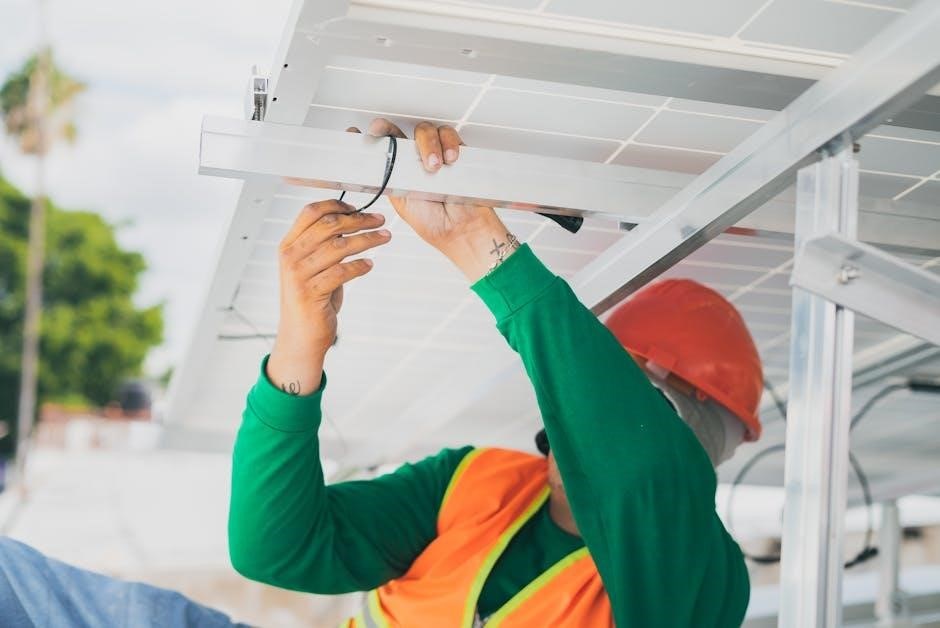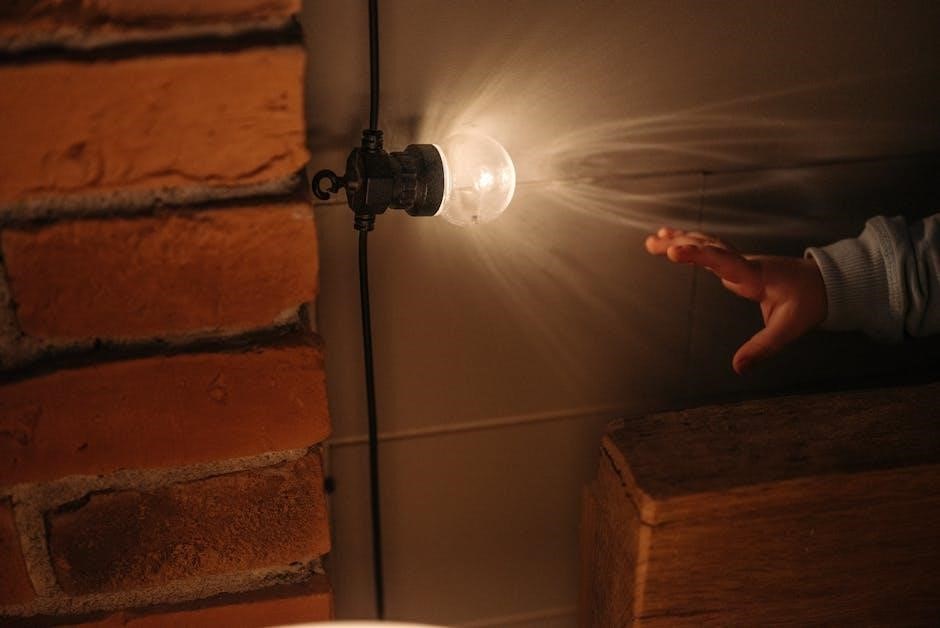AS/NZS 3000 Wiring Rules: A Comprehensive Guide
The AS/NZS 3000 Wiring Rules serve as a cornerstone for electrical installations in Australia and New Zealand. This comprehensive guide navigates the complexities of AS/NZS 3000, providing essential insights into the standard’s requirements for design, construction, and verification. It also covers electrical equipment selection.
AS/NZS 3000, often referred to as the Wiring Rules, is the bi-national Australian/New Zealand standard that sets the benchmark for electrical installations. It’s a crucial document that outlines the essential safety requirements for the design, construction, and verification of electrical installations, aiming to protect people from electrical hazards. The standard’s primary goal is to ensure that electrical work is carried out safely and competently.
This standard encompasses a wide range of electrical installations, from residential to commercial and industrial settings. AS/NZS 3000 is continuously updated to reflect technological advancements and evolving safety practices. Compliance with AS/NZS 3000 is often mandatory, with regulatory authorities in both countries enforcing its requirements. The standard is divided into parts, including regulatory requirements and supplementary guidance. The latest edition includes significant changes that impact electricians, inspectors, and others involved in electrical work. It defines key terms and provides clarity on various aspects of electrical installations.
The AS/NZS 3000 aims to provide uniform safety standards, and part one outlines the minimum regulatory requirements for safe electrical installations.
AS/NZS 3000:2018 ⎼ The Current Standard
AS/NZS 3000:2018 represents the latest edition of the Wiring Rules, setting the current standard for electrical installations in Australia and New Zealand. Officially released in June 2018, it took effect in most states and territories on January 1, 2019, mandating compliance for all new electrical installation work. This edition incorporates numerous updates and revisions to enhance safety and clarity in electrical practices.
The AS/NZS 3000:2018 covers the design, construction, and verification of electrical installations, including the selection and installation of electrical equipment. One notable change in the 2018 edition is the requirement for all final sub-circuits to be 30mA RCD protected, encompassing fixed electrical equipment like cooktops and hot water systems. This change aims to provide increased protection against electric shock.
The standard is structured to provide both regulatory requirements and supplementary guidance. Electricians, inspectors, and regulatory authorities must be well-versed in AS/NZS 3000:2018 to ensure compliance and maintain safety.
The AS/NZS 3000:2018 offers a comprehensive framework that promotes safety and clarity in electrical installations.

Key Changes in AS/NZS 3000:2018
The AS/NZS 3000:2018 edition brought about several key changes to the Wiring Rules, significantly impacting electrical installation practices. One of the most prominent updates is the mandatory requirement for 30mA RCD protection on all final sub-circuits. This extends to fixed electrical equipment, such as cooktops, hot water systems, and air conditioners, enhancing safety by minimizing the risk of electric shock.
The 2018 standard also introduces new definitions and clarifies existing requirements to improve understanding and consistency in application. These revisions aim to address ambiguities and ensure that electricians and inspectors interpret the rules uniformly.
Additionally, AS/NZS 3000:2018 includes updated guidelines on cable selection, installation methods, and earthing arrangements. These updates reflect advancements in technology and industry best practices, ensuring that electrical installations are both safe and efficient.
Overall, the key changes in AS/NZS 3000:2018 focus on enhancing electrical safety, improving clarity, and incorporating modern practices. Compliance with these changes is essential for all electrical work to meet current regulatory standards.
AS/NZS 3000:2007 ‒ An Overview
The AS/NZS 3000:2007 Wiring Rules, published on November 12, 2007, represents a significant update to the regulations governing electrical installations in Australia and New Zealand. This standard aimed to provide uniform essential safety requirements, ensuring the safeguarding of individuals from hazards associated with electrical systems. It was developed by a joint technical committee, reflecting a collaborative effort to enhance electrical safety practices.
AS/NZS 3000:2007 introduced updated regulations designed to improve both safety and clarity in electrical installations. It offered a comprehensive framework divided into two parts, the first outlining the minimum regulatory requirements for a safe electrical installation. This section addressed essential elements necessary for compliance, ensuring a baseline level of safety across all installations.
The second part of the standard served as supplementary guidance, providing additional information and recommendations to support best practices in electrical work. While not mandatory, this guidance offered valuable insights for electricians and inspectors seeking to exceed the minimum requirements and enhance the overall safety and efficiency of electrical systems.
Overall, AS/NZS 3000:2007 played a crucial role in standardizing electrical practices and promoting a safer environment for both workers and the public.

Scope of AS/NZS 3000
The AS/NZS 3000, commonly known as the Wiring Rules, defines the scope and application of its regulations across a broad spectrum of electrical installations. It primarily focuses on the design, construction, and verification of electrical installations, encompassing the selection and installation of electrical equipment that forms an integral part of these systems. The standard aims to provide a comprehensive framework for ensuring electrical safety and compliance in various settings.
The scope of AS/NZS 3000 covers a wide array of electrical installations, including those in residential, commercial, and industrial environments. It addresses the requirements for conductors, cables, wiring systems, and other electrical components used in these installations. The standard also outlines specific guidelines for earthing, bonding, and protection against electric shock, fire, and other electrical hazards.
Furthermore, AS/NZS 3000 extends its reach to cover specialized installations such as those in hazardous areas, medical facilities, and renewable energy systems. It provides tailored requirements for these unique environments, recognizing the specific risks and challenges associated with them. The standard aims to ensure that all electrical installations, regardless of their complexity or location, meet a consistent level of safety and performance.
Ultimately, the scope of AS/NZS 3000 is to safeguard individuals and property from electrical hazards by providing a robust set of rules and guidelines for electrical installations.
Compliance and Mandatory Implementation
Adherence to AS/NZS 3000 is not merely a recommendation; it’s a mandatory requirement for all electrical installation work carried out in Australia and New Zealand. Regulatory authorities enforce compliance to ensure the safety of individuals and property. Electricians, inspectors, and other relevant parties must be well-versed in the standard’s provisions to avoid potential legal and safety repercussions.
The mandatory implementation of AS/NZS 3000 signifies a commitment to upholding consistent safety standards across the electrical industry. It provides a uniform set of rules that all stakeholders must follow, minimizing the risk of errors and inconsistencies in electrical installations. This, in turn, contributes to a safer environment for both workers and the public.
Compliance with AS/NZS 3000 is typically achieved through a combination of education, training, and rigorous inspection processes. Electricians are expected to undergo thorough training programs to gain a comprehensive understanding of the standard’s requirements. Inspectors play a crucial role in verifying that electrical installations adhere to these requirements, identifying and rectifying any deviations.
The mandatory implementation of AS/NZS 3000 is a crucial step in promoting electrical safety and preventing accidents. By ensuring that all electrical installations meet a minimum standard of safety, the standard helps to protect lives and property from the dangers of electricity.
RCD Protection Requirements
AS/NZS 3000 places a significant emphasis on Residual Current Device (RCD) protection to mitigate the risks associated with electrical faults. RCDs are designed to quickly disconnect the electricity supply when a leakage current is detected, preventing electric shock and minimizing the potential for fire. The wiring rules mandate the use of RCDs in various circuits to ensure a high level of safety.
One of the key changes introduced in recent editions of AS/NZS 3000 is the expanded requirement for RCD protection on all final sub-circuits. This means that virtually all circuits supplying power to outlets and fixed electrical equipment, such as cooktops, hot water systems, and air conditioners, must be protected by RCDs. This comprehensive approach significantly reduces the risk of electric shock in residential, commercial, and industrial settings.
The standard specifies the performance criteria for RCDs, including their tripping current and response time. Generally, a tripping current of 30mA is required for most applications, ensuring that the RCD will disconnect the electricity supply quickly enough to prevent serious injury. Regular testing of RCDs is also essential to verify their functionality and ensure that they will operate correctly in the event of a fault.

By mandating widespread RCD protection, AS/NZS 3000 greatly enhances electrical safety and reduces the incidence of electrical accidents.

Part 1: Essential Regulatory Requirements
Part 1 of AS/NZS 3000 establishes the uniform, essential elements that constitute the minimum regulatory requirements for a safe electrical installation. It serves as the bedrock for electrical work in Australia and New Zealand, outlining mandatory practices and standards that all electricians and inspectors must adhere to. These regulations are designed to safeguard individuals from hazards arising from the installation, operation, and maintenance of electrical systems.
This section encompasses a wide array of critical aspects, including wiring methods, earthing arrangements, circuit protection, and the selection of appropriate electrical equipment. It details the specific requirements for conductors, cables, switchboards, and other components, ensuring that they meet the necessary safety and performance standards. Furthermore, Part 1 addresses issues such as voltage drop, electromagnetic compatibility, and the prevention of fire hazards.
Compliance with Part 1 is not merely a matter of best practice; it is a legal obligation. Electricians and other electrical workers are required to have a thorough understanding of these regulations and to implement them diligently in their work. Regulatory authorities enforce compliance through inspections and audits, and failure to meet the requirements can result in penalties, fines, or even the revocation of licenses.
By setting out these essential regulatory requirements, Part 1 of AS/NZS 3000 provides a clear and consistent framework for ensuring electrical safety across Australia and New Zealand.
Part 2: Supplementary Guidance
While Part 1 of AS/NZS 3000 outlines the essential regulatory requirements for electrical installations, Part 2 serves as a supplementary guide, offering additional information and recommendations to enhance safety and best practices. This section delves into specific aspects of electrical work, providing detailed explanations and practical advice to assist electricians in making informed decisions and implementing effective solutions.
Part 2 covers a wide range of topics, including cable selection, installation methods, earthing techniques, and protection against overcurrent and earth faults. It offers guidance on designing electrical systems for various types of premises, such as residential, commercial, and industrial buildings. Furthermore, it provides insights into specialized installations, such as those in hazardous areas or involving renewable energy sources.
Unlike Part 1, which is mandatory, Part 2 is intended as a resource for electricians to expand their knowledge and improve their skills. While adherence to the guidance in Part 2 is not legally required, following its recommendations can significantly enhance the safety, reliability, and performance of electrical installations. It encourages a proactive approach to electrical work, promoting best practices and innovative solutions.
By providing this supplementary guidance, Part 2 of AS/NZS 3000 empowers electricians to go beyond the minimum requirements and strive for excellence in their work, ultimately contributing to a safer and more efficient electrical environment.
Transitional Arrangements and Updates
The implementation of new editions or amendments to AS/NZS 3000 Wiring Rules is typically accompanied by transitional arrangements to allow the electrical industry to adapt to the changes. These arrangements recognize that electricians, inspectors, and other stakeholders require time to familiarize themselves with the updated requirements and adjust their practices accordingly.
During the transitional period, which usually lasts for a specified duration after the publication of the new standard, both the previous and current editions of AS/NZS 3000 may be considered acceptable for compliance purposes. This allows projects that were designed or commenced under the previous standard to be completed without the need for major modifications.
However, it is essential to be aware of the specific transitional arrangements in place and to ensure that all electrical work complies with either the previous or current edition of AS/NZS 3000. Regulatory authorities may provide guidance and clarification on the application of the transitional arrangements to avoid any confusion or non-compliance.
Furthermore, AS/NZS 3000 is subject to periodic updates and amendments to reflect advancements in technology, changes in industry practices, and lessons learned from incidents. Electricians and other stakeholders should stay informed about these updates and ensure that they are using the most current version of the standard to maintain compliance and promote safety. Subscribing to updates and attending industry training sessions are crucial for staying informed.
Impact on Electricians and Inspectors
The AS/NZS 3000 Wiring Rules significantly impact the roles and responsibilities of electricians and electrical inspectors. Electricians must possess a thorough understanding of the Wiring Rules to design, install, and maintain electrical installations that comply with the standard’s safety requirements. They need to stay updated with the latest revisions and amendments to ensure their work adheres to current regulations.
Inspectors, on the other hand, play a crucial role in verifying the compliance of electrical installations with AS/NZS 3000. They must have an in-depth knowledge of the Wiring Rules to conduct thorough inspections, identify potential hazards, and ensure that installations meet the required safety standards. Their expertise is vital for safeguarding the public and preventing electrical accidents.
Both electricians and inspectors are responsible for upholding the integrity of electrical installations and protecting lives and property. Continuous professional development, including training courses and industry seminars, is essential for them to maintain their competence and stay abreast of changes in the Wiring Rules. This ensures they can effectively fulfill their respective roles and contribute to electrical safety.
Therefore, the AS/NZS 3000 Wiring Rules mandate a commitment to ongoing learning and adherence to the highest standards of electrical practice for both electricians and inspectors.
Accessing AS/NZS 3000 Documents
Accessing the AS/NZS 3000 documents is crucial for electricians, inspectors, engineers, and anyone involved in electrical installations. These documents, which contain the Wiring Rules, are essential for ensuring compliance and safety in electrical work. However, obtaining these documents often requires navigating various channels and understanding copyright restrictions.
The official source for AS/NZS 3000 documents is Standards Australia and Standards New Zealand. They typically offer the standards for purchase in both physical and digital formats. These can be accessed through their respective websites or authorized distributors. Purchasing the documents ensures that you have the most up-to-date and accurate version of the Wiring Rules.
While some older versions or excerpts of AS/NZS 3000 may be available online through various sources, it’s important to exercise caution when using them. Always verify the authenticity and currency of the document before relying on it for any electrical work. Using outdated or unofficial versions can lead to non-compliance and potentially dangerous situations.
Educational institutions and professional organizations may also provide access to AS/NZS 3000 documents for their students or members. Check with your school or association to see if they offer this resource. Remember, adhering to copyright laws is essential when accessing and using these documents.
Resources and Support
Navigating the AS/NZS 3000 Wiring Rules can be complex, making access to reliable resources and support crucial for electrical professionals. Several avenues exist to assist in understanding and implementing the standard effectively, ensuring safety and compliance in electrical installations.
Industry associations like NECA (National Electrical and Communications Association) offer valuable resources, including training courses, technical advice, and updates on changes to the Wiring Rules. These associations often have experts available to answer questions and provide guidance on specific aspects of the standard.
Standards Australia and Standards New Zealand, the organizations responsible for publishing AS/NZS 3000, also provide support through their websites and customer service channels. They offer clarification on the standard’s requirements and address inquiries related to its interpretation.
Educational institutions and training providers offer courses and workshops on AS/NZS 3000, covering the theoretical and practical aspects of the Wiring Rules. These courses are designed to equip electricians and other professionals with the knowledge and skills needed to comply with the standard. Online forums and communities dedicated to electrical work can also be valuable sources of information and peer support.
